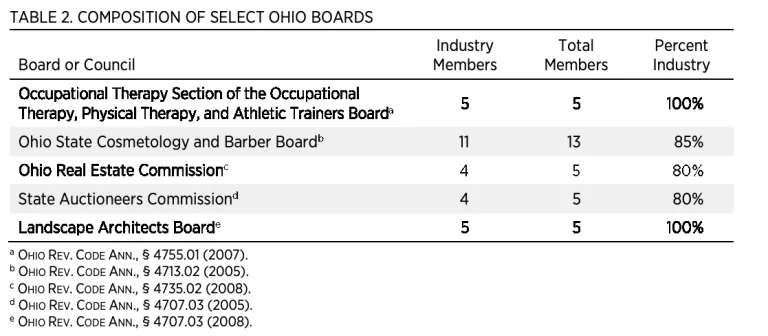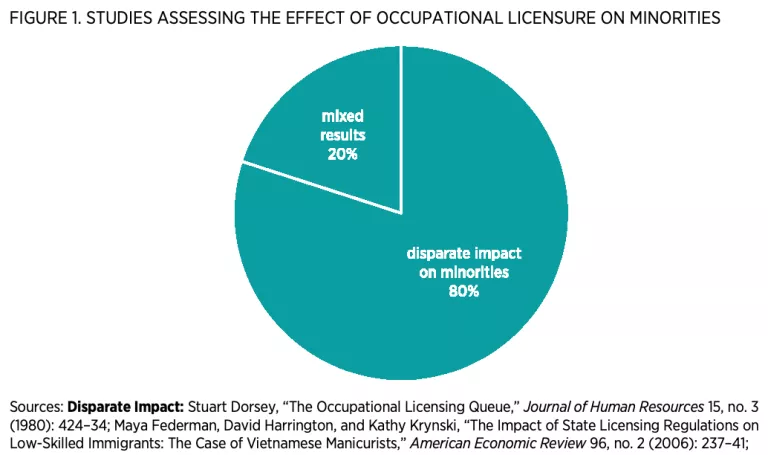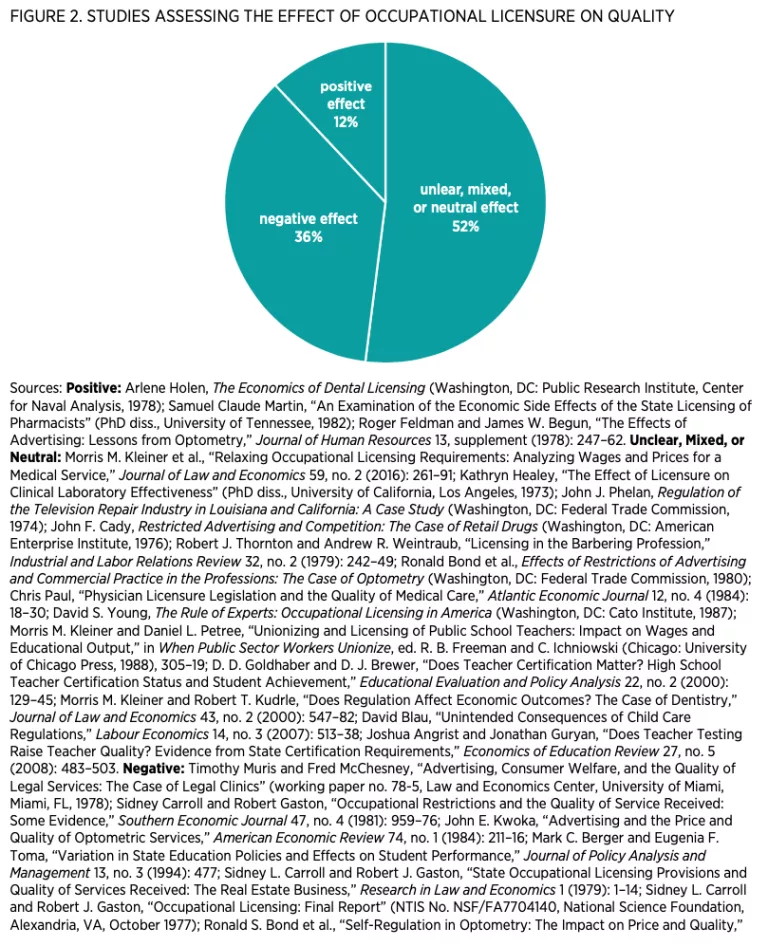- | Regulation Regulation
- | State Testimonies State Testimonies
- |
Ohio Occupational Licensure and Universal Recognition
Testimony before the The Ohio Senate, General Government and Agency Review Committee
Chair Schuring, Vice Chair Rulli, Ranking Member O’Brien, and distinguished members of the Senate General Government and Agency Review Committee:
My name is Matthew Mitchell. I am an economist and a senior research fellow at the Mercatus Center at George Mason University, where I direct the Equity Initiative. Mercatus scholars working on the Equity Initiative study public policies that favor particular firms, industries, or occupations. In recent years, my colleagues and I have been studying occupational licensing laws, and I am grateful for the opportunity to discuss our findings with you.
In my testimony, I wish to focus on three points:
- Licensing is a substantial barrier to employment, imposing a cost to the economy and a disparate burden on certain vulnerable populations.
- Licensing does little to enhance either consumer safety or the quality of services; it does, however, increase prices for consumers.
- Successful reform is difficult, but not impossible. Policymakers must be able to cast conspicuous votes in the general interest while special interest power must be limited.
An Employment Barrier that Is Economically Costly and Individually Burdensome
Licensing represents a significant and growing barrier to work. Nationally, the share of the workforce that is required to have an occupational license has increased more than fourfold in the past 50 years. As of 2015, nearly one in five working Ohioans—18.1 percent of the state’s workforce—was required to be licensed.
As licensing burdens have increased nationwide, they seem to have depressed interstate migration of those in licensed professions. Economists Janna Johnson and Morris Kleiner estimate that between-state migration of those who are licensed is 36 percent lower than that of members of other professions.
These burdens have an economic cost. In separate research, Kleiner and Evgeny Vorotnikov estimate that, each year, licensure may cost the US economy between 1.8 and 1.9 million jobs, result in between $6.2 billion and $7.1 billion in lost output. They also estimate that licensure creates a misallocation of resources that costs the US economy between $183.9 billion and $197.3 billion. In Ohio alone, they estimate that licensure has eliminated more than 67,000 jobs, has resulted in nearly $210 million in lost annual output, and has created a $6 billion annual misallocation of resources.
Aspiring entrants to a large number of professions—ranging from upholsterer and animal breeder to cosmetologist—are now required by the state of Ohio to obtain a government-issued license to work. It can take months and hundreds of dollars to obtain these licenses. Among 40 low- to moderate-income occupations licensed by Ohio, the average aspiring worker is required to spend 350 days in training and pay $188 in fees before he or she may obtain a license. This does not count either the cost of the education or the income that people forgo when they spend months in often-unnecessary training. According to the Institute for Justice, Ohio’s licensing laws are the 20th most burdensome in the country.
Licensure is often arbitrary. As shown in table 1, licensing requirements often don’t match the risk posed to the public by certain professions. Compared with emergency medical technicians, aspiring cosmetologists in Ohio must undergo 10 times as many months of training; would-be auctioneers (who are unlicensed in 20 states) must complete more than 10 times as much training; and high school coaches must complete more than 80 times as much training.

Licensing boards are dominated by members of the professions they oversee. About 86 percent of Ohio occupational licensure boards are required by law to have a majority of their members work in the professions they oversee. See table 2 for board composition data in a sample of Ohio boards. Owing to vacancies, many boards are composed entirely of industry insiders. This presents a legal concern in light of the US Supreme Court’s decision in North Carolina State Board of Dental Examiners v. FTC, which held that states may be liable for antitrust violations when boards are dominated by members of the professions they oversee and when elected officials fail to actively supervise these boards. It also creates a practical concern that boards will tend to act as industry cartels, controlling entry of new members rather than ensuring public safety.

Licensing reduces employment opportunities, especially among certain communities. High barriers to employment pose particular difficulties to lower-skilled, lower-educated populations, to immigrants, to non-English speakers, to those with criminal records, and to those who move frequently, such as military spouses. As shown in figure 1, 80 percent of the studies Mercatus scholars reviewed find that licensure has a disparate impact on minorities.


In states where the scope of licensure for low- to moderate-income occupations has grown more rapidly, there is less absolute income mobility, as measured by the chances that an individual raised in a relatively low-income household will move up the income distribution.
Those with criminal histories are particularly likely to be stymied by these laws. The Council of State Governments Justice Center estimates that nationally about 15,000 laws and regulations limit the ability of those with prior convictions to obtain state occupational licenses. Among these, 6,000 are blanket or mandatory restrictions. This means that a decades-old mistake can bar an aspiring worker from employment, even in fields that are unrelated to the original offense. Ironically, it may also land the worker back in incarceration as unemployment has been found to be a key driver of recidivism.
Licensure presents an especially steep employment barrier for military spouses. About 35 percent of working military spouses are either licensed or certified. And compared with the broader population, military spouses are 10 times more likely to have moved across a state line in the past year. When military spouses were asked to name the biggest challenges to employment, 22 percent identified the inability to transfer their professional licenses from one state to another. This helps to explain why, in 2017, the military spouse unemployment rate was 16 percent, nearly four times the national average.
Licensure Does Not Seem to Increase Quality or Safety but It Does Raise Prices
The most common justification for occupational licensing is that it is necessary to ensure quality and safety. Unfortunately, it seems to fall short in attaining this goal. In theory, licensure could increase the quality and safety of services if it were to successfully screen out low-quality workers, equip workers with the right skills to perform their jobs safely, or both. On the other hand, theory also suggests that licensure could decrease quality and safety. This could happen in two ways. First, licensure may insulate service providers from market competition, and quality tends to be enhanced by market competition. Second, by raising prices and limiting the quantity of providers, licensure may reduce the availability of needed services. In some cases, this can lead to tragedy. For example, when there are fewer electricians in an area, homeowners are more inclined to perform their own electrical work, leading to more injuries.
Because the economic theory is ambiguous, one must turn to the data. In figure 2 I present a survey of the empirical work on licensure and quality. Most studies find that licensure either has mixed, unclear, or neutral effects on quality. Interestingly, however, more studies find a negative effect of licensure on quality than find a positive effect.

There is abundant evidence that licensure raises prices. Economic theory is unambiguous: supply restrictions such as licensure tend to raise prices. And the evidence supports this theory. In a Mercatus assessment of 19 peer-reviewed studies, my colleagues and I found that licensure is associated with higher prices in all 19. Reviewing many of the same studies, Obama administration officials similarly concluded that the association between licensing and higher prices is “unequivocal.”
Successful Reform Is Difficult but Not Impossible
Licensing reform efforts are difficult to implement successfully. The consumers and the aspiring professionals who suffer from anticompetitive licensing regimes are numerous and typically politically unorganized. On the other hand, the industry insiders who benefit from these regimes are comparatively few in number and typically well organized. Economists and political scientists have long blamed this pattern of diffuse costs and concentrated benefits for the persistence of inefficient and inequitable policy. And this pattern has made licensing reform an uphill battle, even though experts on across the political spectrum tend to agree that current licensing laws are inefficient and anticompetitive.
Drawing lessons from successful reform. Despite the advantages enjoyed by special interests, history affords a number of examples in which the general interest has prevailed. In areas as varied as trade, race relations, and airline policy, special interests have occasionally lost their privileges while general and diffuse interests have benefitted from a more level and open playing field.
There are a number of important lessons to draw from these cases. But perhaps the most important is that institutional reforms must permit policy makers to cast conspicuous votes in the general interest and limit the power of special interests to dominate the process.
In the case of occupational licensing, five potential reforms follow this pattern:
- An independent commission. One potential reform would be to establish an independent commission. It should be composed of experts familiar with the economic literature on licensure and with no financial stake in the current regime. It should be charged with identifying and eliminating burdensome and anticompetitive licensing laws. And, ideally, lawmakers should be bound to take its advice in whole or not at all. This type of structure can ensure that state licensing regimes serve the general interests of the public and not the special interests of protected industries.
- Requiring less restrictive means of regulation. The state of Nebraska recently adopted a reform that highlights a different approach. There, the Occupational Board Reform Act of 2018 requires legislative committees to review 20 percent of licenses under their jurisdiction each year and all licenses under their jurisdiction every five years. The review process requires committees to gather information on the number of licenses the board has “issued, revoked, denied, or assessed penalties against” and the reasons for these actions. It also requires committees to review board composition, assess board activities, and to compare these activities with the way other states regulate the occupation.
Most importantly, the act stipulates that licenses are warranted only when they address “present, significant, and substantiated harms” and if such a harm is found to exist, the legislation requires policymakers to use the “least restrictive” regulation necessary to protect consumers from undue risk. Finally, the act establishes the following hierarchy of regulations, from least restrictive to most restrictive:
- Market competition
- Third-party or consumer-created ratings and reviews
- Private certification
- Specific private civil cause of action to remedy consumer harms
- Deceptive trade practices under the Uniform Deceptive Trade Practices Act
- Mandatory disclosure of attributes of the specific goods or services
- Regulation of the process of providing the specific goods or services to consumers
- Inspection
- Bonding or insurance
- Registration
- Government certification
- Occupational licensure
- Reversing the burden of proof. Arizona has taken a third approach. There, the recently passed Right to Earn a Living Act aims to strengthen existing law, which had declared, “the right of individuals to pursue a chosen business or profession, free from arbitrary or excessive government interference, is a fundamental civil right,” and had directed courts to “apply heightened judicial scrutiny to cases involving occupational licenses and the right to earn a living.”
The new act stipulates that “any person may file an action in a court of general jurisdiction to challenge an occupational regulation” and creates a presumption against a state agency’s authority unless the regulation is “demonstrated to be necessary to specifically fulfill a public health, safety, or welfare concern.” The law clarifies that “health, safety or welfare . . . does not include the protection of existing businesses . . . against competition.” These new provisions provide an avenue of relief to individuals harmed by occupational licensing and create a new accountability mechanism for regulators.
- Easing burdens for particular populations. Because licensure can be particularly burdensome for particular populations, many states have moved to ease burdens for specific categories of workers.
Many states, for example, have eased the burden on those with criminal histories by requiring agencies to determine, before workers have applied for their license, whether a criminal record will disqualify them from obtaining it. Another approach is to waive the application fees of those below a certain income level.
Because licensure imposes particularly steep burdens for peripatetic military personnel and their spouses, a number of states have moved to ease that burden for this particular population. The most common approach, adopted by every state but Connecticut, is to somehow recognize out-of-state licenses of current or former military personnel, their spouses, or both. This can take a number of forms. In Tennessee, Texas, and Utah, for example, active-duty military personnel and their spouses may work without a license so long as they possess a valid out-of-state license. In the other 46 states that recognize out-of-state licenses, state agencies must grant in-state licenses to those military personnel and their spouses who currently possess valid out-of-state licenses. In 32 states, regulators are required to conduct an expedited review process in order to determine the validity of out-of-state licenses. In 35 states, regulators are required to issue temporary licenses during the review period. These temporary licenses can be helpful because they permit recently relocated members of the armed forces or their spouses to get to work right away.
While these approaches are certainly beneficial for these populations, they fail to alleviate the burden borne by most licensed workers.
- Universal licensing recognition. Another approach—also pioneered in Arizona—allows any state residents who are currently licensed by another state to obtain an occupational license in their state of residence. While economists and antitrust officials have long recommended licensure portability, this proposal takes the idea a few steps further than other proposals. Typically, licensure portability reforms have focused on particular professions, such as nursing, and have required multiple states to agree to an interstate compact. That type of reform may still be susceptible to the sort of regulatory capture problems that have long dominated state-level licensure.
Universal licensure recognition, however, would allow legislators to serve the general public by easing licensure burdens while mitigating the sort of special-interest pleading that so often dominates regulatory reform. Interestingly, the previously mentioned reform may be a stepping stone to this reform. In Arizona, the universal recognition bill simply amended previous statutory language that had recognized the out-of-state licenses of active duty military personnel and their spouses so that all Arizona residents with out-of-state licenses could operate.
None of these approaches are mutually exclusive. Indeed, they all reinforce one another and aim to correct for a natural imbalance that tends to favor concentrated and organized interests over diffuse and unorganized interests. Policymakers who value consumer protection, lower prices, and greater opportunities for employment—especially among lower-skilled and lower-educated populations—would do well to consider these reforms.
Thank you for the opportunity to share my research with you today. I look forward to answering any questions you may have.

